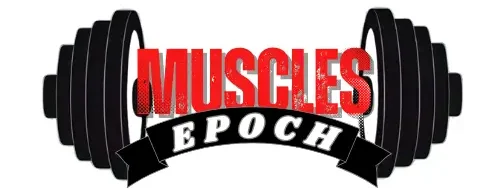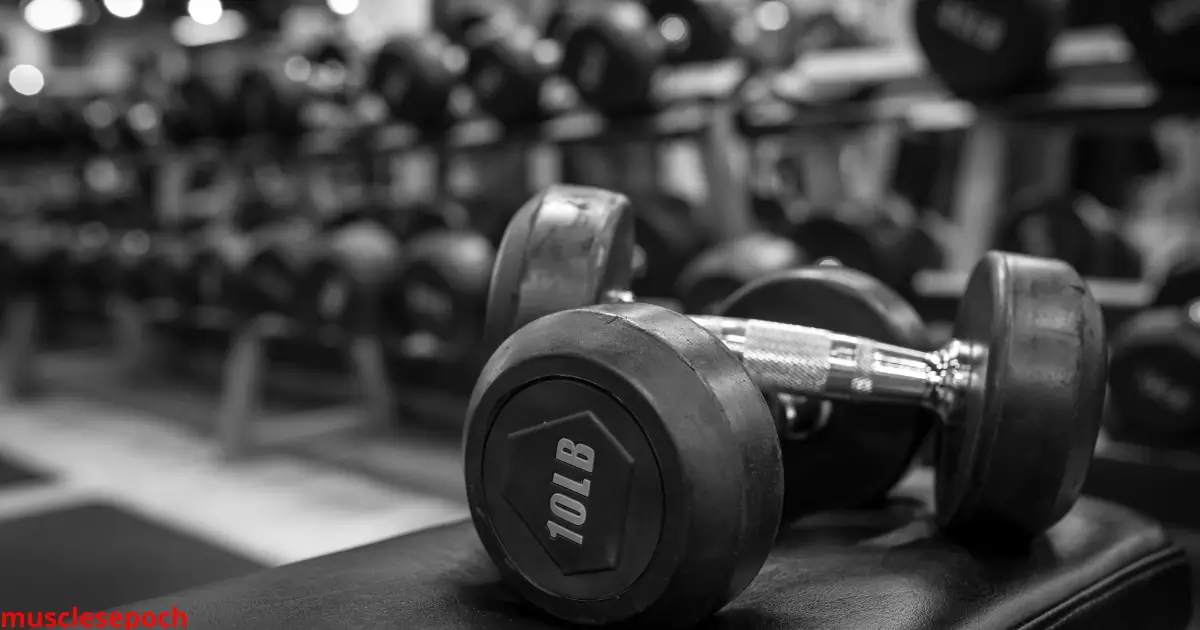Whether you’re training at home, in a small gym, or just starting your fitness journey, dumbbells are one of the most versatile tools for building strength and muscle. A dumbbell only workout allows you to effectively train every major muscle group without needing bulky machines or a full gym setup. For both beginners and intermediate lifters, this approach provides a simple, scalable path to progress, improve form, and build a solid foundation.
In this guide, we’ll break down a complete dumbbell-only workout routine designed to target your entire body. You’ll learn how to structure your push, pull, and leg days, optimize your training for muscle growth, and avoid common mistakes — all with just a pair of dumbbells.
Why Dumbbell Workouts Are Great for All Levels
Perfect for Home or Limited Space Training
One of the biggest advantages of a dumbbell-only workout routine is its adaptability to small or limited spaces—making it ideal for home gyms, apartments, or travel. Unlike bulky machines or barbells, dumbbells are compact, portable, and versatile, requiring very little storage or setup.
You don’t need a full commercial gym to build strength and muscle. A pair of adjustable or fixed-weight dumbbells, a mat, and maybe a bench or stability ball can support a full-body training plan. This makes dumbbell training accessible for people who prefer working out at home, have limited time, or want a cost-effective fitness solution.
Additionally, training in a familiar environment can help beginners feel more comfortable and consistent in their routine. With proper planning and progressive overload, you can achieve impressive results using just dumbbells—no matter the size of your workout space.
Dumbbell Only Workout Routine:Scalable for Beginners and Intermediates
One of the key strengths of a dumbbell-only workout routine is its scalability—it can grow with you. Whether you’re just starting your fitness journey or have been training for a while, dumbbell exercises can be easily adjusted to match your current strength and skill level.
For beginners, using light dumbbells and focusing on mastering form and technique helps build a solid foundation. Movements like goblet squats, dumbbell presses, and bent-over rows can be performed with controlled tempo and lower weights to reduce injury risk and improve neuromuscular coordination.
As you progress into the intermediate stage, the same exercises can be intensified by increasing the weight, reps, or sets. You can also incorporate variations like unilateral movements (e.g., single-arm presses or lunges) to challenge balance and core stability. Adding tempo changes or supersets can further enhance muscular endurance and hypertrophy.
Because dumbbells allow for both bilateral and unilateral training, they’re a great tool for identifying and correcting muscular imbalances as you advance. The adaptability of dumbbell workouts makes them a long-term, sustainable approach to strength and muscle building for lifters at all stages.
Builds Functional Strength Across All Muscle Groups
Dumbbell workouts aren’t just about looking good—they’re highly effective for building functional strength, which means improving the kind of strength you use in everyday activities. From lifting grocery bags to climbing stairs or improving sports performance, dumbbell exercises train your muscles in ways that translate directly to real-life movement patterns.
Unlike machines that isolate muscles in fixed positions, dumbbells require you to stabilize and control the weight through a full range of motion. This activates smaller stabilizing muscles along with the major movers, leading to better overall muscular balance, coordination, and joint health.
With a full-body dumbbell routine, you can target all major muscle groups:
- Upper body: Chest presses, rows, shoulder raises, and curls
- Lower body: Squats, lunges, deadlifts, and step-ups
- Core: Russian twists, weighted sit-ups, and dumbbell carries
This holistic approach not only builds strength and size but also improves mobility, posture, and injury resistance. Over time, you’ll find your daily movements feel easier and more controlled—thanks to the functional foundation developed through consistent dumbbell training.
Full-Body Dumbbell Workout Plan
Push Day
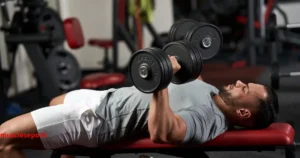
“Push Day” focuses on training all the upper body muscles responsible for pushing movements. These include the chest, shoulders, and triceps—muscles that work together in exercises like presses and extensions. For beginners and intermediates using dumbbells, a Push Day workout builds upper body strength, improves posture, and helps develop a balanced physique.
Here’s a breakdown of each muscle group and sample dumbbell exercises:
- Chest (Pectorals):
- Dumbbell Bench Press – A staple move to target the chest with added stabilization challenge.
- Dumbbell Chest Fly – Stretches and contracts the chest through a wide range of motion.
- Incline Dumbbell Press – Emphasizes the upper chest and front shoulders.
- Shoulders (Deltoids):
- Dumbbell Shoulder Press – A compound movement that hits all three heads of the shoulder.
- Lateral Raises – Isolate and strengthen the side delts for broader shoulders.
- Front Raises – Focuses on the anterior deltoids, often underused in pushing movements.
- Triceps:
- Overhead Dumbbell Triceps Extension – Great for hitting the long head of the triceps.
- Dumbbell Kickbacks – Isolate the triceps and improve definition.
- Close-Grip Dumbbell Press – A chest press variation that shifts the emphasis to the triceps.
This structured approach ensures that each muscle is adequately trained while promoting joint stability and symmetry. Push days also complement the pull and leg sessions in a PPL (Push/Pull/Legs) split, offering a balanced upper-body routine that promotes consistent strength gains.
Pull Day : Back, Biceps
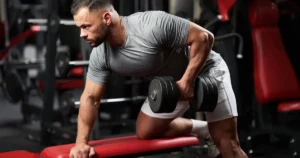
“Pull Day” focuses on all the muscles involved in pulling movements—primarily the back and biceps. These muscle groups work together to perform rows, curls, and other pulling exercises. For beginners and intermediate lifters following a dumbbell-only program, Pull Day is essential for developing a strong posterior chain, improving posture, and balancing upper body development.
Here’s a closer look at the muscle groups and key dumbbell exercises:
- Back (Lats, Rhomboids, Traps):
- Dumbbell Bent-Over Rows – Targets the lats and mid-back while also engaging the rear delts and traps.
- Renegade Rows – A dynamic move that trains the back and core simultaneously.
- Dumbbell Deadlifts – Strengthens the entire posterior chain, including the lower back and glutes.
- Biceps:
- Dumbbell Bicep Curls – A foundational movement that targets both heads of the biceps.
- Hammer Curls – Works the brachialis and forearms, adding thickness to the upper arm.
- Concentration Curls – Isolate each bicep to correct muscle imbalances and enhance definition.
- Rear Deltoids & Upper Back (support muscles):
- Reverse Flys – Strengthens the rear delts and upper back for better shoulder health.
- Shrugs – Targets the trapezius muscles to build a stronger upper back and neck area.
- Face Pulls with Dumbbells (a modified movement) – Supports posture and scapular stability.
Pull Day not only helps build muscle mass but also reinforces balance in your physique. It’s crucial for preventing shoulder injuries and ensuring you’re not overemphasizing the front side of your body with too many push exercises. A strong back and biceps set the foundation for performance in other lifts, athletic activities, and daily movements.
Leg and Core Day
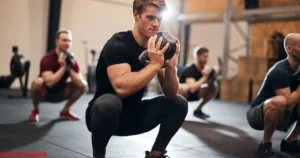
Leg and Core Day is a vital component of any well-rounded dumbbell-only workout plan. It focuses on developing lower body strength, improving core stability, and enhancing overall athletic performance. While many beginners neglect leg training, it’s actually one of the most important days in any program, as strong legs and a solid core support virtually every movement you perform—both in and out of the gym.
Legs (Quads, Hamstrings, Glutes, Calves):
- Dumbbell Goblet Squat: This squat variation helps build your quads, hamstrings, and glutes while promoting proper squat mechanics. Holding the dumbbell at chest level also engages your core.
- Dumbbell Romanian Deadlift (RDL): Great for hamstring and glute development. It teaches proper hip hinging while strengthening your posterior chain and improving flexibility.
- Dumbbell Walking Lunges: A unilateral movement that builds balance, coordination, and strength in the legs and glutes. It also increases core engagement and muscular endurance.
Glutes and Calves:
- Dumbbell Glute Bridge: Targets the glutes directly while also activating the hamstrings and lower back. This is a great low-impact move that enhances hip strength and stability.
- Dumbbell Step-Ups: Step-ups mimic real-life movement patterns and develop leg power and unilateral strength—especially in the quads and glutes.
- Standing Dumbbell Calf Raises: An easy but effective way to target the calves. Strong calves improve ankle stability and enhance overall leg aesthetics.
Core (Abs, Obliques, Lower Back):
- Dumbbell Russian Twists: Strengthen the obliques and improve rotational control and balance.
- Weighted Sit-Ups or Crunches: Increase abdominal resistance to help build definition and core strength.
- Dumbbell Plank Pull-Throughs: A functional core move that also challenges your shoulder and hip stability while promoting anti-rotational strength.
A strong leg and core foundation improves balance, posture, and injury resistance. For those training at home or with limited equipment, dumbbells offer versatility and scalability—making it easy to adjust intensity by changing reps, tempo, or weight. Over time, consistent leg and core work will contribute to improved athleticism, better compound lift performance, and a more symmetrical physique.
Maximizing Results with a Dumbbell-Only Routine
Importance of Proper Form and Tempo
Proper form and controlled tempo are two of the most crucial elements of any workout, especially in a dumbbell-only routine. They ensure that you’re targeting the right muscle groups, reducing the risk of injury, and maximizing your results. Whether you’re a beginner or an intermediate lifter, understanding and applying proper form and tempo can make a huge difference in your fitness journey.
Proper Form: Preventing Injury and Maximizing Muscle Activation
When performing any exercise, proper form is essential to ensure that the right muscles are being engaged. Poor form not only leads to suboptimal muscle activation but also increases the likelihood of injury, particularly in the joints and connective tissues. For example, performing a dumbbell squat with improper knee alignment can stress the knees and lower back, leading to strains and long-term injuries.
- Joint Alignment: Keeping your knees aligned with your toes during a squat or lunge helps to reduce stress on the knee joints.
- Posture: Maintaining a neutral spine during exercises like deadlifts or dumbbell rows ensures that you’re not putting excessive strain on your back, which can result in injuries.
- Breathing: Proper breathing technique—exhaling when lifting and inhaling when lowering—helps with maintaining core stability and can help prevent dizziness or unnecessary strain during your workout.
Tip: If you’re unsure about your form, consider recording yourself or asking a fitness expert for feedback. Many fitness trackers also come with form-checking features that can help you assess your technique.
Tempo: Controlling the Speed of Your Reps
Tempo refers to the speed at which you perform each part of a repetition. This is often broken down into three parts: the eccentric phase (lowering the weight), the concentric phase (lifting the weight), and any pause or hold during the movement. Controlling your tempo is essential for muscle building and ensuring that you get the most out of every repetition.
- Eccentric Phase: Slowing down the lowering part of the movement (such as when you lower the dumbbell in a dumbbell curl or chest press) increases time under tension, which is a key factor for muscle growth.
- Concentric Phase: The lifting part of the exercise should still be controlled, but you can be slightly faster than the eccentric phase. This allows you to use explosive power, which helps build strength.
- Pause and Hold: Pausing at the peak of the movement, like holding at the top of a dumbbell shoulder press or dumbbell squat, can further increase muscle engagement by forcing the muscle to stabilize and hold the weight in place.
Tempo Example for Dumbbell Squat:
- Eccentric (Lowering): 3 seconds
- Pause (At the Bottom): 1 second
- Concentric (Lifting): 1 second
By varying your tempo, you can challenge the muscles in different ways. Slow tempos increase muscle time under tension, which can boost hypertrophy (muscle growth). Faster tempos tend to focus more on building strength and power.
Benefits of Proper Form and Tempo:
- Increased Muscle Activation: By maintaining proper form, you’re ensuring that the muscles you’re targeting are being properly activated.
- Higher Training Volume: With correct form, you can perform more reps and sets safely, which translates to more effective workouts.
- Improved Strength and Endurance: Controlling tempo enhances both strength and muscular endurance, allowing you to train more effectively over time.
- Injury Prevention: Proper form helps to distribute the load evenly across your muscles and joints, reducing strain and injury risk.
Tip for Beginners: Focus on mastering proper form and a controlled tempo with lighter weights before progressing to heavier loads. This will build a solid foundation and help prevent mistakes as you increase the intensity of your workouts.
Applying Progressive Overload with Limited Equipment
Progressive overload is one of the fundamental principles of muscle growth and strength development. It involves gradually increasing the demands placed on your muscles to continually challenge them and encourage adaptation. While it’s often associated with adding more weight on barbells or machines, you can still apply progressive overload effectively—even if you’re working with just dumbbells or limited home equipment.
What Is Progressive Overload?
Progressive overload is the practice of gradually increasing the stress you place on your muscles during exercise. This can be done in several ways:
- Increasing resistance (heavier weights)
- Increasing the number of repetitions or sets
- Reducing rest time between sets
- Slowing down tempo to increase time under tension
- Improving form and range of motion
When your muscles are regularly challenged in new ways, they respond by getting stronger, bigger, and more resilient. Without progressive overload, your results will plateau over time—even if you’re working out consistently.
How to Apply Progressive Overload with Dumbbells or Limited Equipment
When you’re working with just dumbbells or have a limited set of weights, you can still make significant gains using smart strategies:
Increase Reps and Sets
If you can’t move to heavier dumbbells, add more reps or sets to your workout. For example, if you’re doing 3 sets of 10 reps, aim for 4 sets of 12 reps over time. This increases the overall training volume, forcing your muscles to work harder.
Example: Week 1 – 3 sets of 10 reps; Week 2 – 4 sets of 12 reps.
Slow Down the Tempo
Slowing down each rep increases time under tension, which makes the muscles work harder and stimulates growth—even with lighter weights.
Example: Lower the dumbbell over 3 seconds, pause at the bottom for 1 second, lift over 2 seconds.
Shorten Rest Periods
By reducing rest time between sets, you increase the workout’s intensity, making your muscles work harder and recover under more pressure.
Example: Start with 60 seconds rest between sets, then reduce to 45 seconds over the weeks.
Other Creative Overload Methods
Add Supersets or Circuits
Combine exercises back-to-back (with no rest in between) to increase intensity. For example, pair dumbbell squats with lunges, or dumbbell presses with shoulder raises.
Unilateral Work
Train one side of the body at a time (like single-arm presses or single-leg squats). This not only increases difficulty but also improves balance and symmetry.
Add Isometric Holds
Hold a movement at its peak contraction point—for example, pausing at the bottom of a dumbbell squat or the top of a bicep curl—for 5–10 seconds. Isometric training increases muscle endurance and strength without requiring extra weight.
Track Your Progress
Keeping a workout journal or using a fitness app is essential for progressive overload. Record your:
- Exercises performed
- Reps and sets
- Rest intervals
- How challenging the session felt (RPE – Rate of Perceived Effort)
This makes it easier to identify when it’s time to push further.
Dumbbell Only Workout Routine:Recovery, Nutrition, and Tracking Progress

Building muscle and strength with a dumbbell-only workout isn’t just about the workouts themselves—it’s about how you recover, what you eat, and how well you track your progress over time. These three pillars are essential for ensuring your hard work in training translates into real, visible results.
Recovery: Allowing the Body to Rebuild Stronger
Recovery is when the magic of muscle growth happens. Every time you train, you create tiny tears in your muscle fibers. Recovery is when those fibers rebuild—and grow stronger.
Key recovery strategies include:
- Get 7–9 hours of sleep per night. Sleep is when the body produces growth hormone and repairs tissue.
- Take rest days seriously. With a 3-day dumbbell routine (e.g., Push/Pull/Legs), use the remaining days for light activity or rest.
- Use active recovery on off-days—such as walking, stretching, or yoga—to promote blood flow and reduce soreness.
- Listen to your body. If you’re unusually sore, fatigued, or your performance dips, it may be a sign you need extra rest.
Nutrition: Fueling Growth and Performance
No matter how well you train, progress will stall without proper nutrition. Your body needs fuel to power workouts and building blocks (like protein) to repair and grow muscle tissue.
Tips for optimizing nutrition:
- Prioritize protein: Aim for 0.7–1 gram of protein per pound of body weight daily. Good sources include lean meats, eggs, dairy, legumes, and protein supplements.
- Eat enough calories: Muscle growth requires a caloric surplus. Use a TDEE calculator to estimate your daily needs, then eat slightly above that.
- Time your meals: Eating a protein-rich meal within 1–2 hours post-workout helps jumpstart recovery.
- Hydrate well: Muscles are 70% water, and dehydration impairs performance and recovery. Aim for 3–4 liters of water daily.
Tracking Progress: Measuring What Matters
Tracking your progress is vital to stay motivated and ensure your training is moving in the right direction. Without data, it’s hard to know what’s working and what needs adjusting.
Effective ways to track:
- Workout logs: Record exercises, sets, reps, weights, and how hard each session felt.
- Photos and measurements: Weekly or bi-weekly progress photos and body measurements (waist, arms, thighs) help show physical changes.
- Strength benchmarks: Track how many reps you can do with a certain weight and monitor improvements over time.
- Fitness apps: Use apps like MyFitnessPal, Strong, or Fitbod to make logging easier and more organized.
Final Thoughts
Don’t underestimate the power of sleep, nutrition, and progress tracking. These elements aren’t optional—they’re essential for muscle growth, performance, and long-term consistency. Think of recovery as the time your muscles actually grow, nutrition as the fuel for growth, and tracking as the map that guides your journey.
Together, these factors ensure that your dumbbell-only routine delivers real results.
Conclusion
You don’t need a gym full of equipment to achieve serious results — just a consistent plan, a pair of dumbbells, and dedication. This dumbbell only workout routine empowers both beginners and intermediate lifters to build strength, improve muscle tone, and stay committed from the comfort of their own space.
Stick to the structure, focus on form, and challenge yourself with progressive overload. Whether you’re just starting or looking to simplify your training, this plan gives you the tools you need to succeed — one rep at a time.
